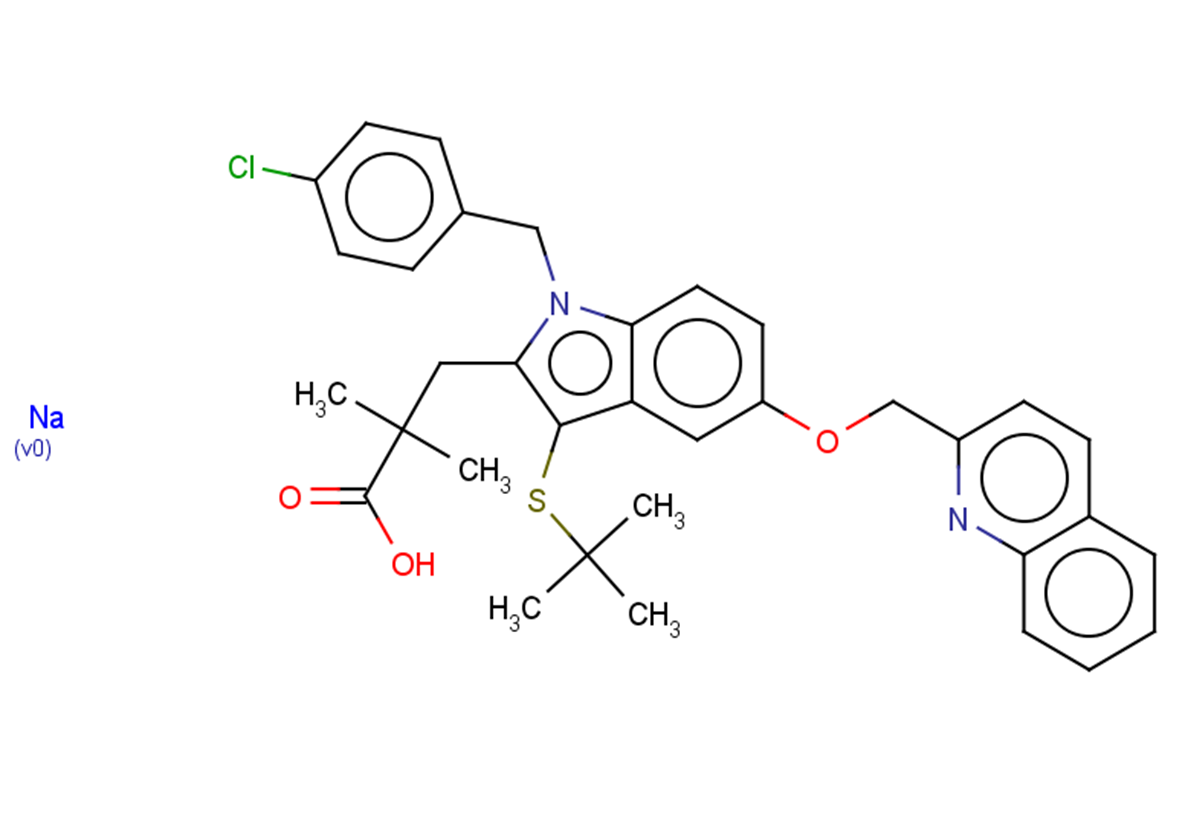Shopping Cart
- Remove All
 Your shopping cart is currently empty
Your shopping cart is currently empty

Quiflapon sodium (MK591) is a selective inhibitor of 5-Lipoxygenase-activating protein (FLAP).

| Pack Size | Price | Availability | Quantity |
|---|---|---|---|
| 2 mg | $85 | 5 days | |
| 50 mg | $747 | 1-2 weeks | |
| 100 mg | $996 | 1-2 weeks |
| Description | Quiflapon sodium (MK591) is a selective inhibitor of 5-Lipoxygenase-activating protein (FLAP). |
| In vitro | Quiflapon sodium is able to block SEB-induced human PBMC cell proliferation. Quiflapon sodium down-regulates three genes (for cathepsin L, IL-17 and guanylate binding protein (GBP)-2) that are up-regulated by SEB [1]. Quiflapon sodium undergoes apoptosis within hours of treatment. Quiflapon sodium also induces rapid activation of the stress kinase, c-Jun N-terminal kinase (JNK), which plays an important role in the apoptosis process. Quiflapon sodium triggers apoptosis in prostate cancer cells without inhibition of PI3K-Akt or ERK. Moreover, MK591 and LY294002 (an inhibitor of PI3K) exert a synergistic effect in inducing apoptosis in prostate cancer cells [2]. Quiflapon sodium (MK591) influences cAMP response element-binding protein but not Sp1[4]. |
| In vivo | In hyperoxia-exposed mice, treatment with Quiflapon sodium (20, 40 mg/kg) resulted in alveolar development similar to that observed in mice breathing room air, in contrast to untreated hyperoxia-exposed mice which exhibited altered alveolarization without inflammation [3]. Treatment with Quiflapon sodium (320 mg/kg) significantly reduced amyloid accumulation in the brain compared to placebo-treated mice. Additionally, Quiflapon sodium effectively decreased brain levels of IL-1β and led to a significant reduction in both total and phosphorylated Ser133 CREB levels [4]. |
| Cell Research | LNCaP cells (appr 3×10^5) are plated and treated with inhibitors or solvent vehicle for varying periods of time. Then the cells are lysed in lysis buffer containing 0.2% CHAPS detergent plus protease and phosphatase inhibitors, and the enzymatic activity of Akt is measured by a kit following methods supplied by the manufacturer. |
| Animal Research | The Tg2576 transgenic mice expressing human APP with the Swedish mutation (K670N/M671L) are used. They are genotyped by PCR analysis using tail DNA and kept in a pathogen-free environment, on a 12-hour light/dark cycle and have access to food and water ad libitum. All the experiments presented in this paper are performed with female mice. Starting at 7 months of age, mice are randomized to receive MK-591 (40 mg/kg weight) (n=11) or vehicle (n=9) in their chow diet for 8 months until they are 15 months old. Considering that each mouse eats on average 5 g/day of chow diet and the diet is formulated for 320 mg Quiflapon sodium per kg diet, the final dose of the active drug is approximately 40 mg/kg weight/day. During the study, mice in both groups gained weight regularly, and no significant difference in weight is detected between the two groups. No macroscopic effect on the overall general health is observed in the animals receiving active treatment. Post-mortem examination shows no sign of macroscopic pathology in any of the organs considered (spleen, liver, thymus, ileum). |
| Alias | MK591 |
| Molecular Weight | 610.16 |
| Formula | C34H35ClN2NaO3S |
| Cas No. | 147030-01-1 |
| Relative Density. | no data available |
| Storage | Powder: -20°C for 3 years | In solvent: -80°C for 1 year | Shipping with blue ice. | ||||||||||||||||||||||||||||||
| Solubility Information | H2O: Insoluble DMSO: 50 mg/mL (82.08 mM), Sonication is recommended. | ||||||||||||||||||||||||||||||
Solution Preparation Table | |||||||||||||||||||||||||||||||
DMSO
| |||||||||||||||||||||||||||||||

Copyright © 2015-2024 TargetMol Chemicals Inc. All Rights Reserved.